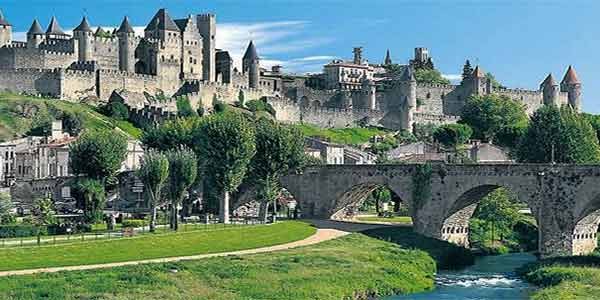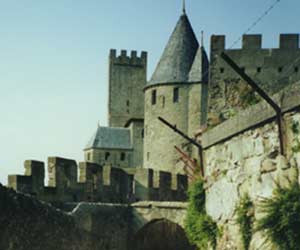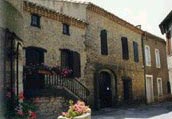By Wade Rowland, from his novel Ockham’s Razor
Photos by Christine Collie Rowland

I got hooked on travel early in life. And for many years, beginning long before my first passport, it seemed to me that one of the transcendent travel experiences must be to walk the grey stone ramparts of Carcassonne, preferably at night and preferably in the autumn. This notion was firmly lodged in my brain when, as a diffident fourteen-year-old, I discovered the books of one of the most popular travel writers of any era, Richard Halliburton.
In his heyday in the ‘twenties and ‘thirties, Halliburton was a household name in America and one of the most widely-read authors of his time. He had discovered early on that what his audience wanted from him was not culture, not politics and geography but adventure and, above all, the romance of travel. And that is what he gave them. He travelled on a shoestring to the most exotic corners of the globe and when adventure did not present itself, he created it.
One example will give you the flavour: broke in Buenos Aires while writing the newspaper series that was to become New Worlds to Conquer he spurned an easy bail-out from his publisher and instead invested his last few dollars in a trained monkey and a broken down hurdy gurdy. Performing in the city’s parks and streets earned him: a) a night in jail for by-law infractions; b) a memorable yarn for the newspapers and c) enough money for his passage all the way north to Rio. The unfortunate monkey died on the voyage – not to worry, he milked that story too.
Halliburton blew in to Carcassonne late in 1921 on his first trip to Europe as a young Princeton graduate with literary ambitions, and he wrote about it in The Royal Road to Romance, the first of his five, wildly successful travel books. He was on his way by bicycle and knapsack from Paris to Andorra. The air at the foot of the Pyrenees was sharp and clear…
“Late on that glittering November evening I left the modern ville basse on foot, crossed the seven-hundred-year-old bridge over the river that separates the fortress from the modern town, looked up the sharp escarpment, and behold, before my eyes, nine centuries disappeared. I became an anachronism, a twentieth-century American living in eleventh-century France. In one sweep the Middle Ages were revealed. A magical moonlit city of walls and towers and battlements, defiant and impregnable, rose before me….Not a person was to be seen, not a light showed, nor a dog barked as I climbed the path and walked beneath the massively fortified gate, through the double line of enormous walls, into a strange world. Incredibly ancient houses, dark and ghostly, reeled grotesquely along the crazy streets. My footsteps echoed. There was no other sound…”.
Halliburton spent the night exploring the city and eventually watched the dawn break from the battlements:
“A man appeared in the streets, and then another and another. I knew the hours of enchantment were gone. The ghosts of Crusaders and Saracens and Visigoths, which must have been abroad that night, had marched down the shafts of the ancient wells into the subterranean caverns, to watch over the fabulous treasures which any true native of the citadel will tell you lie buried there. With the night departed Yesterday. The real, unromantic present lived again…”.
 The “real, unromantic present” was where I was, seventy-one years after young Richard had dashed off those breathless lines, and I too was about to see Carcassonne for the first time. My partner Christine beside me, her legs aproned in a large-scale Michelin road map, I was approaching from the north at the wheel of a red, rented Peugeot, purring along undulating roads through the brooding forests of the Black Mountains and then across the flatlands of the River Aude on a narrow, shoulderless highway picketed with two-hundred-year-old plane trees, and finally on through the dusty streets of the modern lower town of Carcassonne.
The “real, unromantic present” was where I was, seventy-one years after young Richard had dashed off those breathless lines, and I too was about to see Carcassonne for the first time. My partner Christine beside me, her legs aproned in a large-scale Michelin road map, I was approaching from the north at the wheel of a red, rented Peugeot, purring along undulating roads through the brooding forests of the Black Mountains and then across the flatlands of the River Aude on a narrow, shoulderless highway picketed with two-hundred-year-old plane trees, and finally on through the dusty streets of the modern lower town of Carcassonne.
We rounded a corner bracketed by grey stone warehouses and there, on a rise beyond the river, was a vision for which no photograph could have prepared us. We pulled over to the curb and got out of the car to stand and stare. Nowhere in Europe has a fortified medieval city been preserved so perfectly, or on such a scale. Despite the sheer mass of its miles of walls and its sixty towers and barbicans, it seemed to float above the surrounding fields and vineyards, like a mirage.
The town site on its rock outcropping overlooking the River Aude has been prized for its strategic importance from ancient times and may have been fortified even before the Romans built the first of the walled citadels there. The final touches to the fantastic, many-towered marvel one sees today were put in place by Saint-Louis and his successor Philip the Bold toward the end of the thirteenth century. It survived virtually intact until the mid-1800’s under the protection of the French military and was in the last half of that century completely and brilliantly restored under the inspired direction of architect Eugéne-Emmanuel Viollet-le-Duc.
There are naturally quibbles about details of the restoration and refinements are continuously being made. Slate roofs, for instance, are slowly being converted to the more authentic baked clay tile. Still, no one denies that the place looks pretty much as it did eight or nine centuries ago when knighthood was in flower, Crusades were in fashion and the stirrup crossbow was the latest and greatest in military hardware.
We had been told that, since we were staying at a hotel within the walls, we would be able to drive our car right inside the citadel, where the hotel had a parking space for us. That sounded reasonable over the telephone from Paris, but when we actually saw the city and its main gate – just wide enough to accommodate a pair of mounted knights in armour – we began to have our doubts. We held our breath as I eased the Peugeot into the gap in the eighteen-foot-high outer wall, across the broad lists to the second, much higher wall, under the portcullis of its massively-fortified gate and then inched our way through the pedestrians thronging the cobbled street inside, which is perhaps ten feet wide from doorknob to doorknob. There were places where neighbours could comfortably have shaken hands across the street from corbelled second stories.
 Driving a modern vehicle down these ancient passageways, through the main square with its giant well which provided security from long sieges, past the castle keep to the gargoyle-encrusted cathedral next door to our hotel, was like living a page out of A Connecticut Yankee in King Arthur’s Court.
Driving a modern vehicle down these ancient passageways, through the main square with its giant well which provided security from long sieges, past the castle keep to the gargoyle-encrusted cathedral next door to our hotel, was like living a page out of A Connecticut Yankee in King Arthur’s Court.
No wonder Halliburton was drawn here in his search for the romantic. France has arguably more romance per square mile than any other country in Europe, but the pocket of the country for which Carcassonne provides a focal point is the fountainhead of the very notion itself. The literary form we call romance has its roots in the writings of the troubadours who first appeared here in the region known as Languedoc in the eleventh century. Poets and wandering minstrels to a remarkably open and tolerant society, they wrote of freedom and justice and gallantry and of a kind of courtly love that was entirely new to literature. In troubadour castles throughout the south of France – Puivert and Les Baux are among the most famous – women of the nobility established “courts of love” in which they defined suitable subject matter for troubadour songs, maintained the rules of grammar of the native langue d’oc and provided advice for the lovelorn. Their poetry competitions were the talk of the land and the winners were crowned with peacock feathers.
From the ninth to the thirteenth century, Languedoc was the social, cultural and political cockpit of France.There was a strong tradition in Languedoc and in the region of Carcassonne in particular, of questioning Christian orthodoxy as represented by a poorly-trained, dissolute and avaricious Catholic clergy. All over Europe in the twelfth and thirteenth centuries groups of the faithful were seeking a return to first principles and a new purity of faith.
But it was in Languedoc that the strongest of these movements took root. Known as Catharism (from the Greek katharos: purity), it held that the world of God was the world of the spirit, while the material world, the world of time, was the realm of the Devil. Thus anything to do with the body – eating, drinking, marriage and procreation, material possessions – was inherently evil. Rules of conduct for the priestly class, the white-robed “perfecti” , were drawn from the Christian Gospels and strictly applied: the taking of life was forbidden and the perfecti were strict vegetarians. Fasting was frequent; celibacy was obligatory.
Pope Innocent III, alarmed at the spread of what the Church referred to as the Albigensian Heresy (for the town of Albi, where a famous debate between Catholic and Cathar clerics took place), dispatched to the region Dominico Guzman, later St. Dominic and founder of the Dominican order. He undertook his mission of preaching against the heresy with relish but was soon forced to admit failure. He was prophetic in defeat: “I have preached,” he lamented, “I have entreated, I have wept…the rod must now do the work of benediction. Towers will be torn down, walls toppled, and ye shall be reduced to bondage. This is how might shall prevail where meekness has failed.”
Events came to a head in 1208 when a papal legate was assassinated near Carcassonne. Innocent III seized on this pretext to launch a holy war which became known as the Albigensian Crusade. The pattern for the savagery that was to follow was set on a July day in 1209 in Béziers, where ecclesiastic authorities had identified 200 known Cathars. After a brief resistance the town was taken by storm and 20,000 men, women and children were put to the sword or burned to death, including hundreds who had packed the cathedral seeking sanctuary. “Kill them all,” the Crusade’s prelate is said to have urged. “God will know his own.”
Although Carcassonne itself changed hands several times during the Crusade, only once was a siege mounted. Mighty wooden engines that could catapult boulders, rolling siege towers to help storm the walls and other marvels of the military technology of the time were of little use against so well designed a defensive position and the besieging army found its most effective weapon to be mining the walls – tunnelling under them to cause them to collapse. The defenders counter-mined successfully, meeting the invading forces far underground and driving them back before they could complete their destruction. In the quiet of an evening’s contemplation close by the walls, one envisions with a shudder the rat-like ferocity of these desperate, clawing struggles in pitch darkness.
The heretical beliefs of the Cathars proved remarkably persistent despite the eventual defeat of the last of their military strongholds, and to effect a final solution Pope Gregory IX set up the infamous Inquisition, presided over by the Dominicans. Its ruthlessness is well-known: in Carcassonne there is, in an out-of-the-way alley, a horrifying museum of the implements of torture used by the inquisitors.There are other reminders: the Inquisition Tower, where suspects were “questioned” before being sent to a prison outside the city walls; the Justice Tower, where it is believed the secret archives of the Inquisitors were stored.
It is the Inquisition Tower which overlooks the fairy tale garden of one of the most romantic hotels in the world, and one of the friendliest and most accommodating in our experience. Hôtel de la Cité’s twenty-three immaculately-detailed rooms are contained within the renovated interior of the old Bishop’s palace, next door to the cathedral. One of three small hotels within the citadel walls and unquestionably the best, its public spaces are worth a visit whether or not you stay there. Especially interesting is the breakfast room/bar with its enormous paintings showing Carcassonne as it must have looked at various stages of its history, from neolithic times through its Roman, Visigoth and medieval French incarnations.

We had asked for a room with a double bed when we’d reserved, always a wise precaution unless you prefer the twins that are much more common in French hotels. None was available, but rather than disappoint us, the hotel staff had upgraded us to a corner suite. We could scarcely believe our eyes. Leaded casement windows opened on to the tiny plaza in front of the cathedral and a breeze billowed tapestry-like curtains in the bedroom and sitting rooms. There was a huge, fragrant bouquet in the foyer. The marbled bathroom featured a walk-in shower the size of a horse stall. The furniture was antique and immaculate and there was art on every wall.
That night, out of gratitude but against our better financial instincts, we ate in the hotel dining room. Our suspicion that his was not a room for triflers was confirmed by the wine list, which had the heft of a big-city phone book. Entrées were priced to suit the budget of someone who could actually afford the suite we’d been given.
We dined more modestly the following evening, in a boÎte called l’Ostal des Troubadours, a tiny Gypsy café on the main square. The tables were cheek-by-jowel but the cassoulet was rich and fragrant, the wine was cheap and, beside us, a small fenestration through three feet of hewn stone looked out onto the castle keep. In a corner of the room, a classically-trained guitarist entertained. We applauded enthusiastically and our appreciation did not go unnoticed; ours was the first table he visited with outstretched hat when his set ended. He was replaced by a boozy singer-guitarist who announced in heavily accented French that he was a purveyor of Irish love ballads, then blithely launched into Leonard Cohen’s Sisters of Mercy.
In the morning there was a wedding in the cathedral for us to watch from our private lookout onto the square and we were late for service in the hotel breakfast room. The staff cheerfully set a solitary table for us outdoors beside the deserted swimming pool and served us croissants, brioche, boiled eggs, fresh orange juice and café au laît on starched linen and silver. We wore our straw hats against the sun. A scented breeze riffled the dazzling white table cloth. We were starring, fantastically, in our own movie, a romance that Halliburton might have written had he lived long enough to acquire a taste for the more sybaritic pleasures of travel. Poor Richard, instead, died trying to cross the China sea in a leaky junk, on the eve of World War 2. He was on his way to San Francisco, creating another adventure, and he vanished without a trace. He wasn’t yet forty. But he’d made that enchanted moment in Carcassonne possible for us, a gift for which I’ll always be grateful.
Although Carcassonne is one of the most-visited tourist sites in France, we found that even during the “season” it is not difficult to find a little peace and quiet. The site is so large (the outer wall is more than a kilometer and a half long) and its streetscape so varied that even when the main tourist alleys are clogged, much of the site remains quiet, and this is particularly true in the the early morning and late evening. A guidebook of some description is absolutely essential to an adequate appreciation of the city and its battlements, and a variety of them are available at any number of shops within the walls. The best of them is Carcassonne in the Days of the Siege, published in English and French by the French government Caisse Nationale des Monuments Historiques et des Sites, and you can find it at the excellent book shop next to the cathedral.
The passage you just read was an excerpt from a chapter in Ockham’s Razor by Canadian author Wade Rowland. For more information about the author, or to read more on this topic, visit his website at: www.WadeRowland.com
Wade Rowland is also the father of our Hilary Rowland, the model turned web designer, our Spring 2000 Cover Story.

Comments are closed.